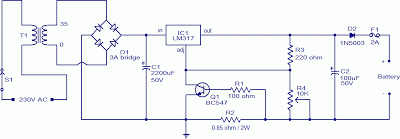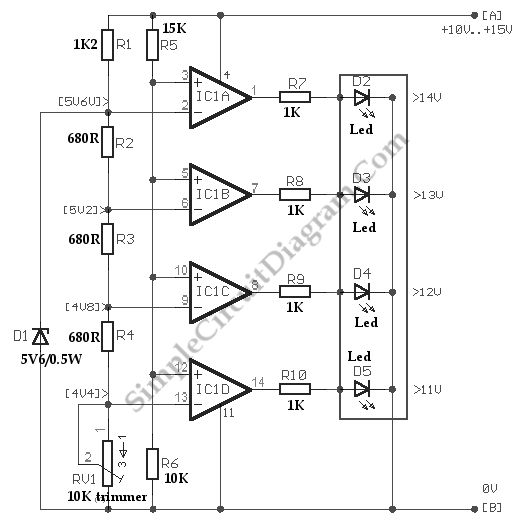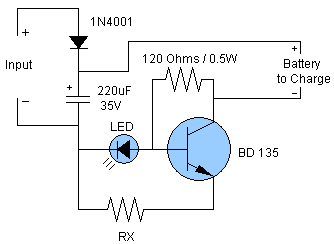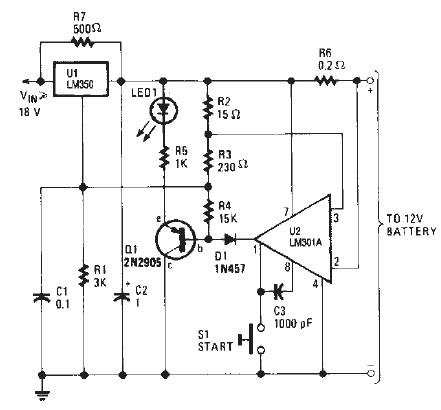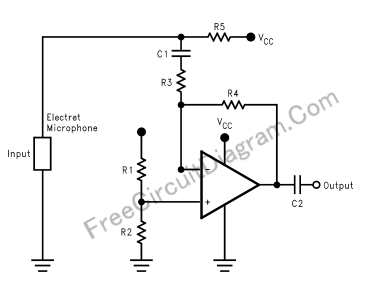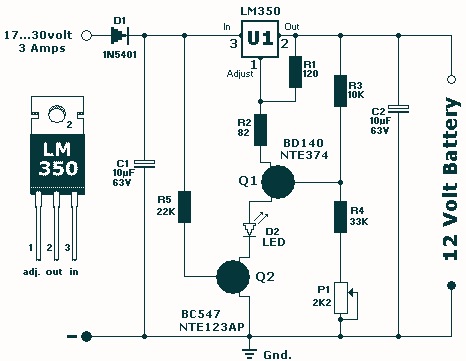
Storage Battery Exerciser

A motorcycle or boat battery that is not needed over the winter is typically charged before being stored for the season, during which it remains unused for several months. This inactivity can lead to the accumulation of lead sludge, resulting in reduced capacity or even complete battery failure. To prevent this, it is essential to keep the battery active throughout the winter. The described circuit effectively maintains battery activity, eliminating the need for recharging during the winter months. A full charge is only required in the spring before the battery is used again.
IC1.A functions as an astable multivibrator with an asymmetric duty cycle, producing a high output for approximately 0.6 seconds and a low output for about 40 seconds. IC1.B operates as a comparator, continuously monitoring the battery voltage with a threshold set to 11.0 V using a trimpot. When the battery voltage drops below this threshold, the comparator output goes low, which turns off D6 and allows the second astable multivibrator, IC1.C, to oscillate at around 1.2 Hz. This causes LED D7 to blink, indicating that the battery requires charging. While the battery voltage remains above 11 V, IC1.B stays high, keeping IC1.A low most of the time. In this state, D4 conducts, and the inverting input of IC1.D is low, resulting in IC1.D being high most of the time, thus keeping transistor T1 off. T1 only conducts during the 0.6-second intervals when IC1.A is high, allowing current to flow through a 12V/3W lamp, which serves as the actual load for the battery. Following this, there is a 40-second period of inactivity. The average current consumption of the circuit is approximately 5 mA. At this consumption rate, a relatively new 40-Ah battery will take about one year to become fully discharged, although this duration may vary based on the battery's condition, necessitating possible recharging during the winter.
The circuit design incorporates essential components such as the astable multivibrators and comparators to ensure efficient battery maintenance. The astable multivibrator IC1.A's asymmetric duty cycle is crucial for creating a load that intermittently exercises the battery without causing significant depletion. The comparator IC1.B plays a vital role in monitoring the battery voltage, ensuring that the battery is not excessively discharged. The use of a trimpot for setting the threshold voltage allows for fine-tuning based on individual battery characteristics and conditions.
Additionally, the blinking LED D7 serves as a visual indicator for users, providing immediate feedback regarding the battery's status and the necessity for charging. The integration of a lamp as the load not only exercises the battery but also provides a practical application of the circuit, demonstrating its functionality in real-world scenarios. The careful selection of components, along with the astable multivibrator's timing characteristics, ensures that the circuit operates efficiently, maintaining battery health over extended periods of inactivity. Overall, this circuit serves as an effective solution for prolonging the life of motorcycle and boat batteries during winter storage.A motorcycle or boat battery that is not needed over the winter is usually charged before being put away for the winter, after which it remains standing unused for months on end. As a result, it accumulates deposits of lead sludge, which can result in reduced capacity or even complete failure of the battery.
If you don`t keep active, you rust! To avoid this, it`s necessary to keep the battery active even during the winter. This circuit does such a good job of exercising the battery that it doesn`t have to be recharged during the winter. It only has to be fully charged again in the spring before being used again. IC1. A is an astable multivibrator with an asymmetric duty cycle. The output is High for around 0. 6 s and Low for around 40 s. IC1. B is wired as a comparator that constantly monitors the battery voltage. Its threshold voltage is set to 11. 0 V using the trimpot. As soon as the battery voltage drops below this value, the comparator goes Low and D6 is cut off, allowing the second astable multivibrator IC1.
C to oscillate at approximately 1. 2 Hz. LED D7 then blinks to indicate that the battery must be charged. As long as the battery voltage is greater than 11 V, IC1. B is High. IC1. A is Low most of the time, and in this state D4 conducts and the inverting input of IC1. D is Low. This means that IC1. D is High most of the time, with T1 cut off. T1 only conducts during the 0. 6-s intervals when IC1. A is High. In this state it allows current to pass through the lamp (12 V / 3 W), which forms the actual load for the battery. After this, darkness prevails again for 40 s. The average current consumption is approximately 5 mA. At this rate, a relatively new 40-Ah battery will take around one year to become fully discharged. However, this can vary depending on the condition of the battery, and it may be necessary to top up` the battery once during the winter.
🔗 External reference
IC1.A functions as an astable multivibrator with an asymmetric duty cycle, producing a high output for approximately 0.6 seconds and a low output for about 40 seconds. IC1.B operates as a comparator, continuously monitoring the battery voltage with a threshold set to 11.0 V using a trimpot. When the battery voltage drops below this threshold, the comparator output goes low, which turns off D6 and allows the second astable multivibrator, IC1.C, to oscillate at around 1.2 Hz. This causes LED D7 to blink, indicating that the battery requires charging. While the battery voltage remains above 11 V, IC1.B stays high, keeping IC1.A low most of the time. In this state, D4 conducts, and the inverting input of IC1.D is low, resulting in IC1.D being high most of the time, thus keeping transistor T1 off. T1 only conducts during the 0.6-second intervals when IC1.A is high, allowing current to flow through a 12V/3W lamp, which serves as the actual load for the battery. Following this, there is a 40-second period of inactivity. The average current consumption of the circuit is approximately 5 mA. At this consumption rate, a relatively new 40-Ah battery will take about one year to become fully discharged, although this duration may vary based on the battery's condition, necessitating possible recharging during the winter.
The circuit design incorporates essential components such as the astable multivibrators and comparators to ensure efficient battery maintenance. The astable multivibrator IC1.A's asymmetric duty cycle is crucial for creating a load that intermittently exercises the battery without causing significant depletion. The comparator IC1.B plays a vital role in monitoring the battery voltage, ensuring that the battery is not excessively discharged. The use of a trimpot for setting the threshold voltage allows for fine-tuning based on individual battery characteristics and conditions.
Additionally, the blinking LED D7 serves as a visual indicator for users, providing immediate feedback regarding the battery's status and the necessity for charging. The integration of a lamp as the load not only exercises the battery but also provides a practical application of the circuit, demonstrating its functionality in real-world scenarios. The careful selection of components, along with the astable multivibrator's timing characteristics, ensures that the circuit operates efficiently, maintaining battery health over extended periods of inactivity. Overall, this circuit serves as an effective solution for prolonging the life of motorcycle and boat batteries during winter storage.A motorcycle or boat battery that is not needed over the winter is usually charged before being put away for the winter, after which it remains standing unused for months on end. As a result, it accumulates deposits of lead sludge, which can result in reduced capacity or even complete failure of the battery.
If you don`t keep active, you rust! To avoid this, it`s necessary to keep the battery active even during the winter. This circuit does such a good job of exercising the battery that it doesn`t have to be recharged during the winter. It only has to be fully charged again in the spring before being used again. IC1. A is an astable multivibrator with an asymmetric duty cycle. The output is High for around 0. 6 s and Low for around 40 s. IC1. B is wired as a comparator that constantly monitors the battery voltage. Its threshold voltage is set to 11. 0 V using the trimpot. As soon as the battery voltage drops below this value, the comparator goes Low and D6 is cut off, allowing the second astable multivibrator IC1.
C to oscillate at approximately 1. 2 Hz. LED D7 then blinks to indicate that the battery must be charged. As long as the battery voltage is greater than 11 V, IC1. B is High. IC1. A is Low most of the time, and in this state D4 conducts and the inverting input of IC1. D is Low. This means that IC1. D is High most of the time, with T1 cut off. T1 only conducts during the 0. 6-s intervals when IC1. A is High. In this state it allows current to pass through the lamp (12 V / 3 W), which forms the actual load for the battery. After this, darkness prevails again for 40 s. The average current consumption is approximately 5 mA. At this rate, a relatively new 40-Ah battery will take around one year to become fully discharged. However, this can vary depending on the condition of the battery, and it may be necessary to top up` the battery once during the winter.
🔗 External reference
